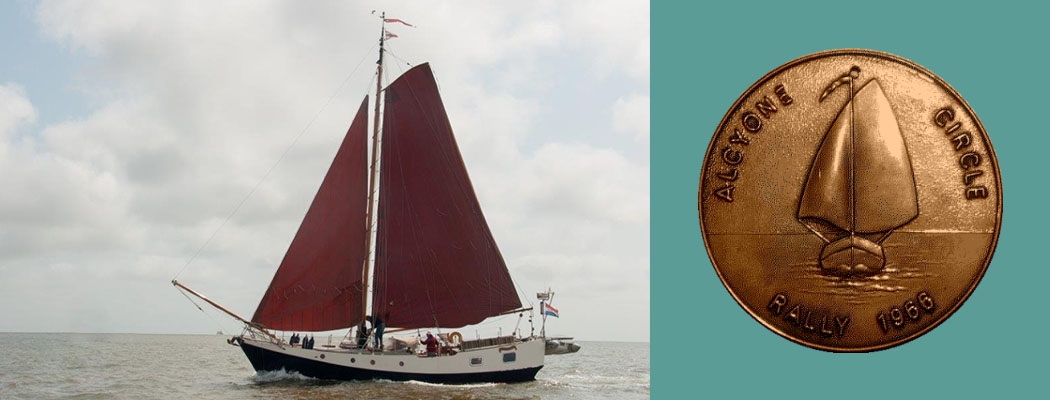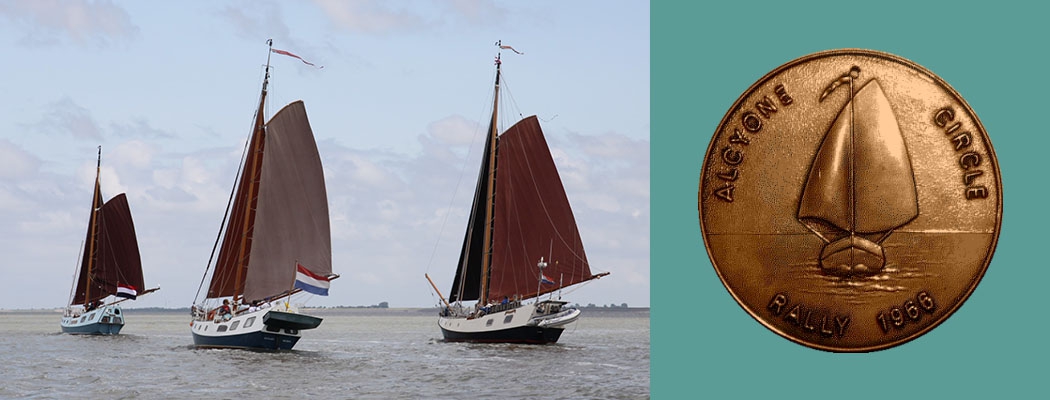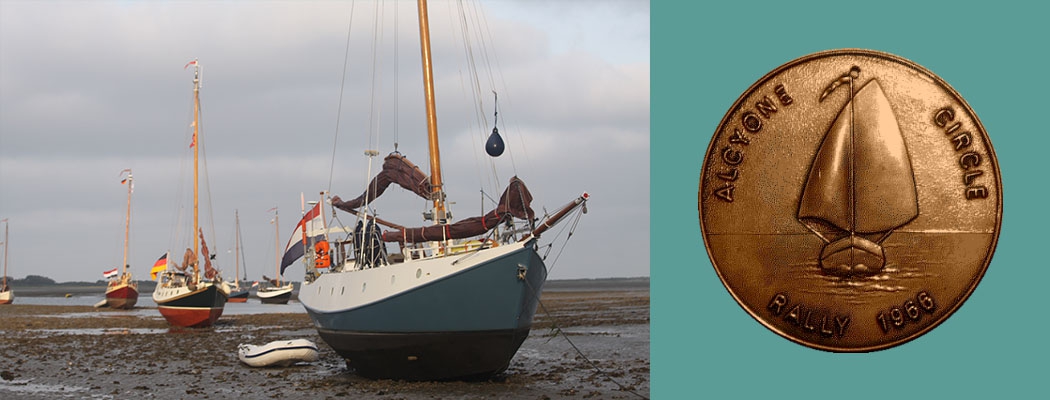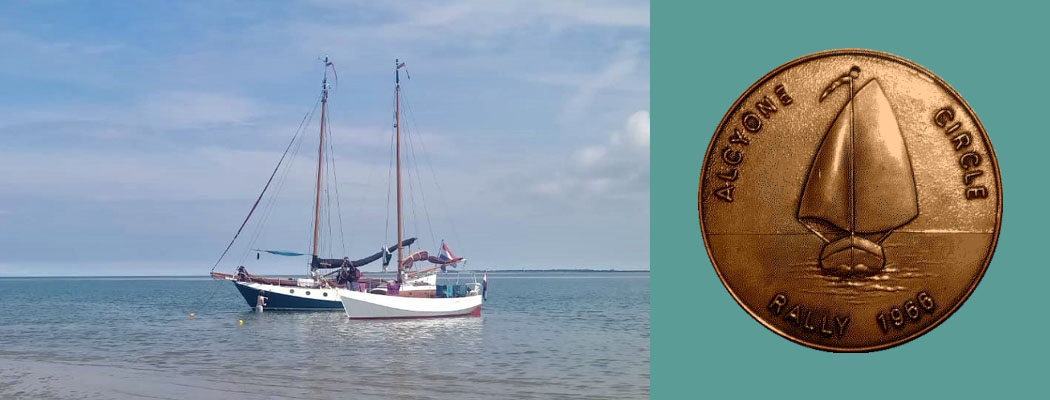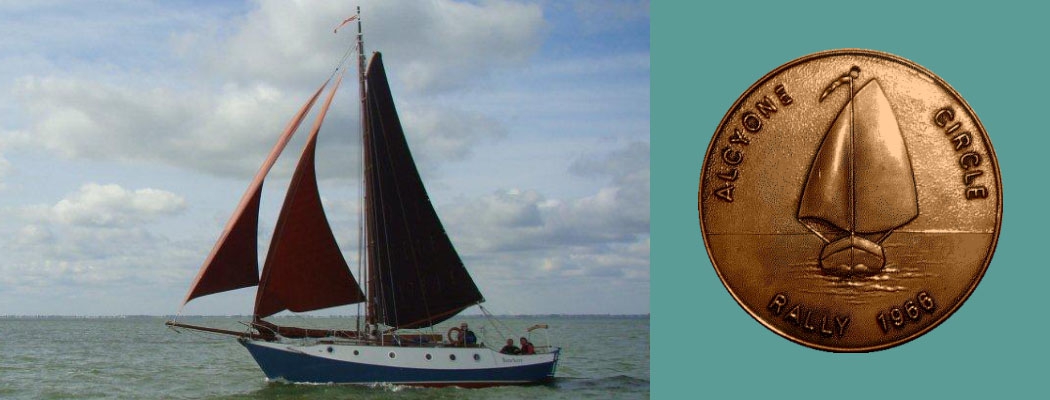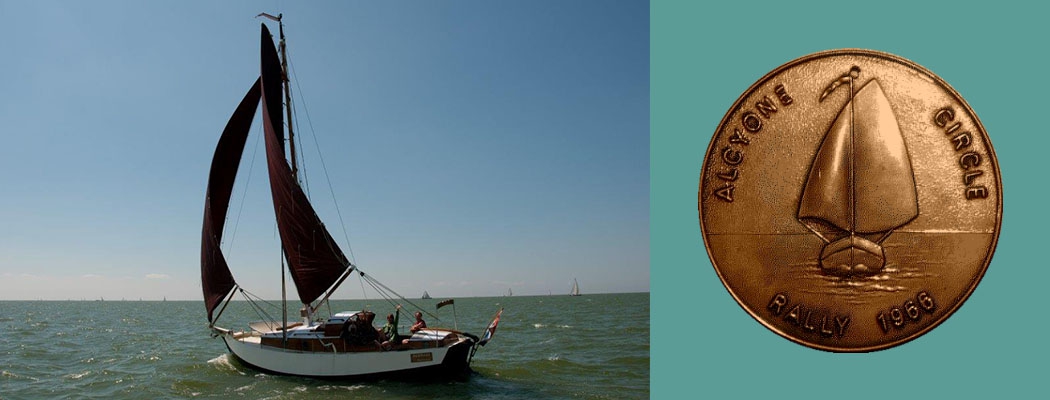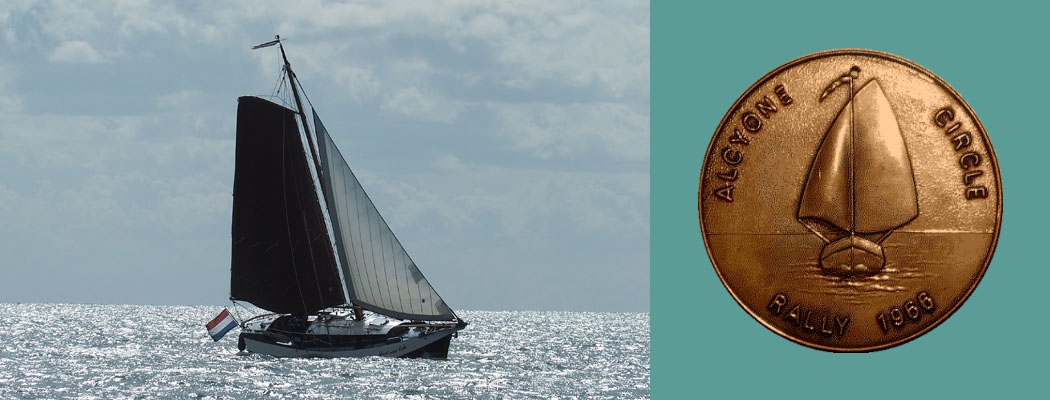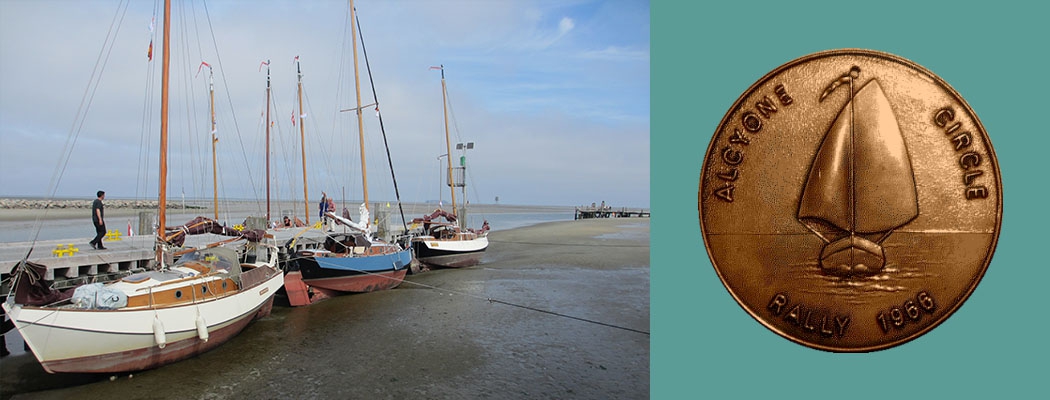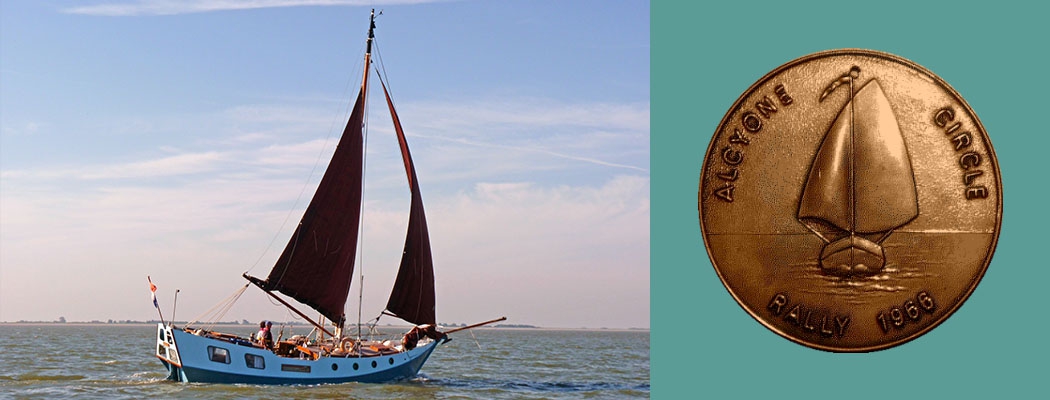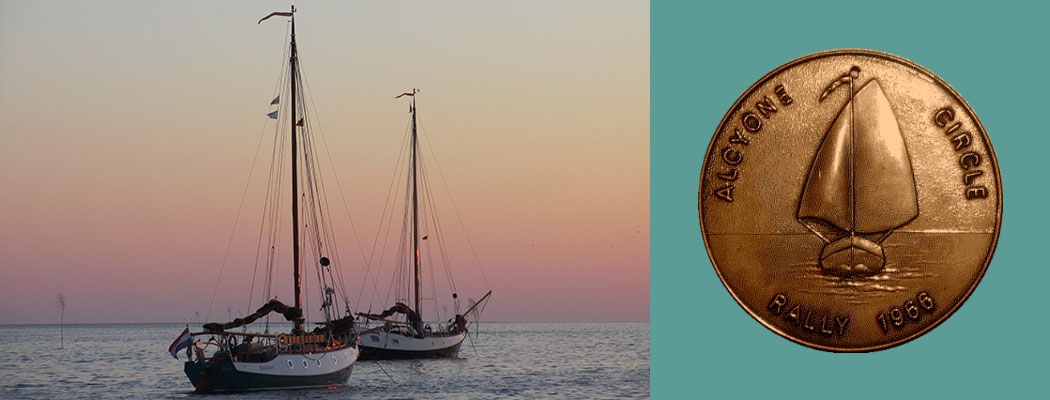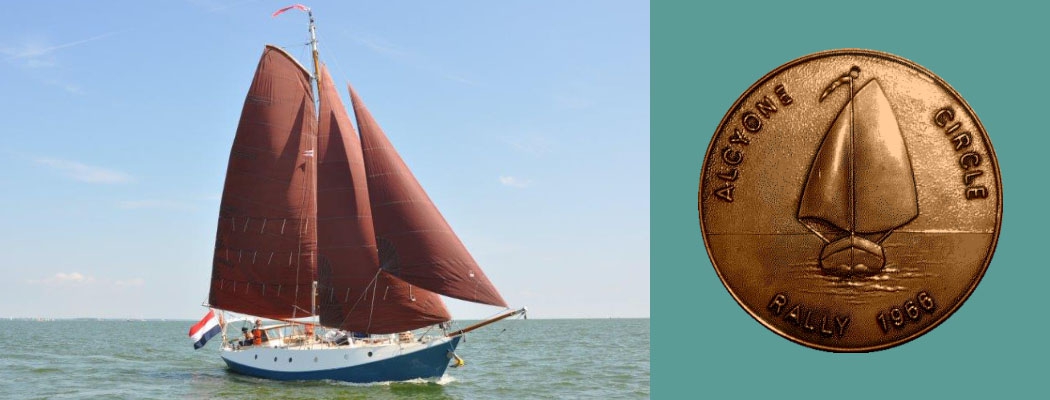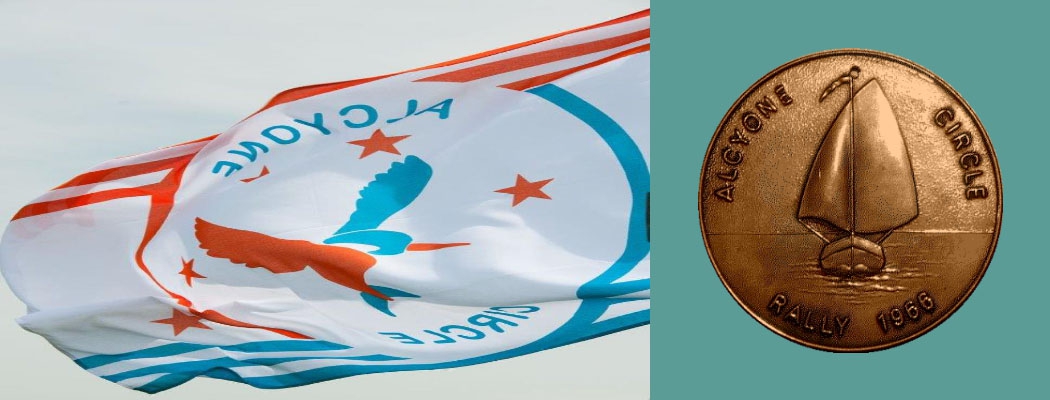 Spurwing
Spurwing
From Sir Percy Wyn-Harris has returned home from his journey round the world in his yacht “Spurwing”.
Our congratulations on a splendid voyage!
We are delighted to say that Sir Percy has sent us an account of the final stages of his homeward voyage, so that we can continue with his log, which we last published in our Newsletter No. 11.
Spurwing Wanders Home
Mauritius, an island something over fifty miles in length from north to south lies, green, mountainous and charming about five hundred miles eastward of Madagascar – within the southern tropics and well out in the wastes of the Indian Ocean.
It was at the end of October last year that Spurwing raised this island from the east after an eventful voyage from Darwin, Australia; it is an island redolent of eighteenth century France and of Victorian England. Two Australian characters, Ron Curnow and Terry Martin formed Spurwing’s crew.
Ron, an erstwhile wanderer about the byways of Asia, by profession an architect, and hailing from Melbourne had been my companion in 1968 – a rewarding companion, and an integral part of Spurwing’s Saraband up the Barrier reef and in the lonely enchantments of the Wessel Islands.
Terry, first met on the Barrier Reef when he was sailing his ill-fated “Coral Sea”, had joined at Darwin, where he had looked after Spurwing while she lay beached in Doctor’s Gully. He was by trade a skilled operator of vast and improbable earth-moving machines.
Port Louis, the capital of Mauritius, lies on the western side of the island and the long narrow anchorage is exposed to westerly winds. So, when we anchored, at the head of the harbour, close to the bustling Town Quay, we put out two anchors and lay to an open moor.
With the Suez Canal blocked by the brickbats of Colonel Nasser and General Dayan, Port Louis has regained something of its ancient glory of the days of sail – days when it was a port of refreshment for ships on their long haul from Capetown to India and the China Coast. Today, however, the massive peaks behind the town no longer look down on the masts of East-Indiamen, but on big tankers and cargo vessels. We, ourselves, lay among some fairly doubtful characters – characters even less appealing than the French privateers of two hundred years ago – there were covies of greedy trawlers from the Far East; a handsome American Spyship regularly discharging into the harbour quantities of garbage, its stench sickly scented with ice cream and orange peel; and two Hush Hush Russians crowded with antennae, and Volga boatmen who spent their time gazing stolidly at the whole Capitalist scene.
We intended to stay three weeks, but stayed five, and then of course found five far too short even to scratch the surface of this fascinating island. Our enjoyment was due in large part to the warm hearted kindness, charm and overwhelming hospitality of Mauritians of every walk of life and origin. Origins here are various, and many Mauritians are of mixed descent – France, Africa, Britain, India and China are the main founts; with Indian Hindus forming 70% of the population, they also form the newly independent government.
In spite of an impossible overpopulation problem, poverty, bad housing and unemployment, and, also in spite of the horrid and bloody communal violence which had erupted so savagely a bare twelve months before, Mauritius has a real and satisfying civilization.
It was Sam Pyndiah, the Physical Education Officer of a large mixed school up in the cool highlands of the island, who opened the door to a tide of friendship. He hailed Spurwing from the quay and took us all up to the school for their Speech Day. Here we met a number of parents and teachers which led in turn to an ever widening circle of charming and interesting people. It would be invidious to mention names, but I must recall putting on my battered and mildewy suit and attending a delightful dinner party given by the Prime Minister and Lady Ramgoolam.
But as we dallied we were getting further into the “hurricane season” and the time of real danger was too close for comfort so we pulled ourselves together and got ready for sea. On Tuesday, December 3rd, having topped up our stores from Mr. Appavou – the Ships Chandler, whose great grandfather some seventy years ago had supplied Capt. Slocum on his famous circumnavigation, we got our anchors aboard and set sail. But not very far. As we cleared the harbour an excursion by Terry up the mast to clear a halliard revealed that three strands of the port runner had parted at the mast head eye. As there was quite a sea running we ran down the coast of the island to the charming anchorage off La Riviere Noire and set to work in smooth water to make good the damage. By nightfall we had a workmanlike repair, and as dark fell on the background of hills, Sam Pyndiah rowed over from his fishing boat to give us a final God Speed.
The gap in the reef at the mouth of the bay is unmarked and the wind was fresh, so we waited for first light before setting out on our passage to Durban 1600 miles away to the south west. Once over the reef and with a splendid fresh south easter on our quarter we laid a course to lead us close northward of the French island of Reunion 90 miles away. All day we tore along under main and genoa at something over six knots with the wind steadily becoming more boisterous. By midnight, with a full moon lighting the tumbling seas and with Spurwing curvetting like an Australian brumby we picked up the Goulet Light on Reunion. Dawn found us sailing fast in smoother water about three miles off the great cliffs of the island. As we got well under the lee of the 4000 foot mountains the wind faltered and died, leaving us to a hateful roll, with the gear crashing and smashing about. The mainsail got badly chafed, and all three of us, soured by some fairly heated recriminations as to guilt, spent a frustrating afternoon getting the damaged main off and bending on our aged and patched spare which was obstinately stuck in an inaccessible corner of the stern locker.
The following morning an essential piece of the rudder assembly came adrift – and drifted to the sea-bed some twelve thousand feet below. Ron had to go over the stern for twenty minutes to secure the rudder with a clamp; he made an excellent job of it, but I was relieved to see the begoggled Ron come climbing back, as although there were no fins about and the danger from sharks probably small, Spurwing was plunging in the scend of the sea and threatening to crash on Ron as he worked in the water.
As we got further to the south our apprehensions of hurricanes faded, but so did the south east trades, the winds becoming unpredictable both in direction and strength; the occasional heavy rainstorms saw the ship’s company gyrating on deck, soaping and showering in the chilly but delicious downpours.
We gave Cap St. Marie at the southern end of Madagascar an offing of nearly one hundred miles and then hauled more to the west on course for Durban. The only excitement on this leg of the voyage, apart from an excellent view of a large whale, occurred on December 17th when my working of the noon sun sight put us a little under two hundred miles off the African Coast. It was a cloudless day with a fresh wind on our quarter – the long crests of the seas breaking a glittering and blinding white in the bright sunlight. In the early afternoon the wind began to freshen out of the hard blue sky. A large tanker coming against us passed a mile to port and quickly vanished astern, leaving us to our own small world once more. Her misty outline, plunging and rolling in the spume blown from the tops of the seas emphasized the growing strength of the wind. Shortly after, in steepening seas and with only our storm staysail set, we were running before a moderate gale; as night fell heavy banks of black cloud filled the whole horizon to starboard – banks almost continuously lit with stupendous whip-flashes of lightning. We watched this display with some uneasiness as the wind was now gusting up to something over gale force, but to my relief, as the hours crept by, the main centre of the storm slowly passed ahead of us, leaving Spurwing at dawn to a gentle breeze and quietening seas. We were lucky; two yachts which caught the centre of this storm in the Mozambique Channel got a real towelling.
The following day we raised the coast of Natal some miles north of Durban, a landfall recommended in the Admiralty Pilot because of the danger of being set too far to the south by the fierce Agulhas current. All the morning we sailed down the coast, a diminutive member of a procession of large vessels making for Durban. As we crept into the narrow entrance of Durban harbour we shaved the side of a harbour tug which was fiaming out. The bearded skipper lent out of the wheelhouse and hailed Spurwing in rude seaworth terms – he was Mike Briant, last seen with Pat, he wife, in the Lagoon, St. Georges, Grenada in 1966 when Spurwing lay close to their Chinese Junk “Ying Hong” which they had sailed from Hong Kong.
We spent last Christmas at Durban, in close company with eighteen other voyaging yachts, packed in four tiers in front of the Point Yacht Club. The club most generously granted all the visitors honorary membership and this meant many kindnesses from the permanent members, splendid showers and a very good restaurant, serving among other things a “Langouste Rocheux Armoricain” of almost spiritual significance.
We lay nine weeks at Durban as Spurwing needed quite a refit. In addition to slipping her in a yard – the first time she had been in a yard since Malta in 1964 – to rebuild the rudder assembly and to do some welding, we also had to replace quite a lot of gear – the anchor chain, halliards and runners – to mention just a few. We had to get our sails repaired and to replace the wireless receiving aerial which had disappeared one night out in the Indian Ocean. Thus we had plenty of opportunity of renewing old friendships and making new ones.
It would be impossible to mention all the doubtful ex-Kenya characters who hailed Spurwing and came aboard to swap yarns of the unregenerate days of forty years ago; highly imaginative yarns of stock theft, leopard hunts, witchcraft, murder and mayhem were nostalgically remembered.
Terry Martin left Spurwing at Durban to go to Pretoria, where following in the footsteps of nearly all my previous crews he got married. He and his bride have now returned to Australia. Tobi Heriz-Smith, a young Englishman who had been teaching in an African Secondary School in Rhodesia, joined us.
By February 22nd this year Spurwing was at long last “ready in all respects” for sea, and amidst the blare of foghorns from other yachts we set off down the harbour. Once clear of the Durban Bluff we turned southwards down the eight hundred miles of exposed and ”wicked” coast to Capetown.
“Wicked” it has been called locally as it is not an easy coastal passage for sailing vessels, since as a rule the wind will blow from the northeast for two or three days and then after a short calm will turn and blow hard from the south. When, it is not uncommon, this wind gets up to strong gale or above it enjoys the epithet “Southerly Buster”. These southerly winds, meeting the south going Agulhas current will raise some quite astonishingly steep and tumultuous seas. East London and Port Elizabeth are almost the only ports of refuge on this long coastal haul, and it is common for small vessels to get at least one good towelling on the passage down.
We got a good fair wind for the first thirty hours and on the second evening out of Durban – a wet, cold, miserable evening – we found ourselves bucking a head wind just off the entrance to East London, so I cravenly sneaked in for a quiet but malodorous night alongside the town’s fish quay. Then, early the following morning on down the coast past Algoa Bay – one of the most unpleasant anchorages in the world in the days of sail; in one great storm alone more than a score of big sailing vessels were driven ashore and wrecked, with heavy loss of life.
But all down this Coast we were lucky, for although we did meet some quite heavy headwinds gusting up to force 6 forcing us to a series of tedious tacks where we seemed to gain little for our labour, we met nothing startling and by the seventh day out of Durban we found ourselves rounding Cape Agulhas, the southernmost point of Africa, and having rounded it we turned on course to the Cape of Good Hope eighty miles to the West North West. That eighty miles was going to give us some fun and an extract from the log gives the picture:
Saturday, March 1st…
17.45 … We are about 5 miles south of Danger Point and the Birkenhead Rock – scene of shipwreck of Troopship Birkenhead in 1852 – decide, owing to indraughts, to sail further seaward which will keep wind aft and boom on port gybe. Course steer 305º. Variation 24º. W. deviation 9º W.
21.30 … Tobi on watch. Wind suddenly freshens and veers, bringing staysail aback and smashing spinnaker boom into three pieces. On port tack. Course to Cape Light Steer 355º. Distance 32 miles.
24.00 … Pick up Cape Light dead ahead flashing 2 and 1 every 30 seconds. Alter course to steer 335º to get 5 miles of offing.
Sunday, March 2nd…
01.00 … Ron on watch. Wind now gusting up to strong gale and above. Big wave catches cockpit on starboard side tearing spray dodger from coaming, splitting coaming and bending stanchion; filled cockpit and knocked in galley hatch. got some gallons of water into the ship, and it took quite a time to make everything ship-shape.
03,.00 … Four miles off Cape of Good Hope, bearing due north magnetic. Wind has eased.
And eased it had, falling right away and as the sun came up we were ploughing along on the engine under the lee of the mountainous Cape Peninsula.
Table Mountain came into sight with Capetown gracefully lapping its lower slopes. “Driver”, “Mjojo”, “Procax”, and “Pacific Crusader” all of whom we had met before were lying in front of the Royal Capetown Yacht Club; they and the Club made us very welcome.
We stayed fourteen days in Capetown. Bob Reinecke, and his wife Pandora, both mountaineers, took me under their wing, and besides staying in their charming house near Simonstown showed me much of the attractive Cape Peninsula. Particularly do I remember the ancient lighthouse on the great bluff which is the Cape of Good Hope. The sheeting rain and the gusting wind only enhanced the grandeur of the place. Pandora took the ship’s company up Table Mountain in the Cable Car for a wander along the mountain’s flat and spacious top.
Then on the Sunday afternoon of March 16th with the wind hard and gusty off Table Mountain we cast off our lines and set out on the 1700 mile run to St. Helena. Immediately astern of us came “Voortrekker” of Trans-Atlantic fame and we exchanged toots on our foghorns as she turned north on her voyage to Durban. Six miles off Capetown and we lay becalmed close to Robben Island – the place of detention of many of South Africa’s political prisoners, a sad reminder, if one were needed, of the shadows over this part of the world.
After an uneventful sail of fourteen days on March 31st, at first light we picked up the shadowy outline of St. Helena, with its great cliffs falling sheer to the sea, and by eight o’clock our anchor went rattling down in the open roadstead off Jamestown, the little capital of the island, lying in a deep defile which cuts through the mountains.
The Governor, Sir Dermod Murphy sent out greetings and offers of hospitality. Ex-Gambians will be interested to know that His Excellency, my kind and splendid host at Plantation House, was in fact our “Spud” Murphy of nearly twenty years ago. He showed us much of this island – a jewel of an island. Memories crowd in: the little main street of Jamestown with its bow windows, still dreaming of the last century: the longest flight of stairs in the world, “Jacob’s ladder”: climbing from the town to the fort on the headland above: tea with Mr. and Mrs. Benjamin behind their shop: the brooding ghost of Napoleon and Longwood House with its Mon. Martineau, French Consul and Curator Extraordinary: and again the many kind and interesting people we met.
A week later – and now with six yachts of the Durban wolf pack in the roadstead we set sail, and with a hard gust from the hills making Spurwing gripe, we shaved under Driver’s stern, skipped round “Woodrose” and took off for Ascension 700 miles to the north.
We had one excitement on this leg. On April 11th when we were something over half way the swivel on the peak halliard block parted, and with the staysail flattened to try and lessen Spurwing’s roll, Tobi and I wound Ron to the masthead in the bosun’s chair. At this point the rope in the bosun’s chair parted, the wooden seat came rattling down and Ron with his safety harness clipped to a shroud shackle hung helpless at the top of the swaying mast. However, we sent up a bowline on a spare halliard and Ron, after a realistic imitation of a dying ostrich, managed to get his feet into the bowline and release the safety clip of the harness. As Ron was dressed in the usual rig of the day – a pair of bathing trunks – it was a Ron somewhat scarified by the safety harness who was finally lowered to the deck. It was a stout effort that with a fresh rope rove for the bosun’s chair Ron was immediately up the mast again and put in an excellent repair.
Three days later we raised Ascension Island, a truly volcanic island, with Green Mountain rising in its centre and barren, contorted, moon country in the coastal plains. Arrived at the open roadstead off the landing steps, often unusable, because of rollers, I found I had previously met the Administrator, Brigadier Macdonald, in 1960 during the hilarious and improbable United Nations Plebiscite in the Northern Cameroons. This led to an enchanting week at the Residency high up on Green Mountain, when Mac showed us all over his bailiwick: from one of the most remarkable farms in the world on the top of Green mountain of all the various communication centres strewn about the island; the water distillation plants and the enormous American airfield serving their Atlantic rocket range.
The highlight was the visit to the NASA Communications Centre for the Apollo moon project. Jim Murphy was in charge of this vital station for the shots to the moon and he took us all round the station; it was at at time when all the chaps were girding their loins to do their essential part in putting the first men on the moon. The centre was an incredible and fascinating glimpse into a future which is going to be so utterly different from the past. I found it somewhat intimidating. As ever the kindness and hospitality of everyone we met on Ascension was heart warming.
Ron wanted to get back to the United Kingdom more quickly than Spurwing’s wander so he joined “Driver” who was sailing to Gibraltar; Tobi continued as sole crew on the passage to Grenada – the longest leg of the whole Spurwing’s wanderings – a distance of over 3200 sea-miles.
Just north of the equator and not far off mid-Atlantic there lies a lonely and intriguing group of rocks – St. Paul’s Rocks – and as they were not far off our proposed track I decided to try and find them. On Friday May 2nd when we were over 900 miles from Ascension, my noon sight put us 98 miles off. Owing to a vicious squall in the evening which put out our dead reckoning the horizon remained empty when, on the following day, we had run our distance down. However, our noon position showed that we had passed the rocks which then lay about nine miles to the south east. So we hauled our wind and clawed back to windward, finally coming up with them in the afternoon. As we closed to within 1 1/2 cables of them we could see the mountainous swells bursting in cascades between the 60 foot rocks and thoughts of a possible landing just quietly died. So we turned away on course and left this solitary dot to the dark and the sea birds.
Once through the doldrums and round the east side of the awkward Equatorial Counter Current we turned and ran westward before the fresh North East Trades towards Grenada. On the twenty seventh day out of Ascension I got at evening twilight good sights of Jupiter, Dubhe and Sirius which put us 54 miles east of Saline Point, the southerly point of Grenada. Due to a failure on my part to allow sufficient for the north going current and also, I suspect, due to bad error in the steering compass, we suddenly found ourselves during the following night close in to the rips and rocks round Kick’em Jenny to the north of the island – a poor landfall. We turned like a scalded cat and beat out to sea and then on long tacks down the dark eastern coast, arriving off Point Saline sometime after dawn. And then across the bay and into the lagoon at St. George’s. It was great fun meeting old friends once more: John Slominski, with whom I stayed; Gordon Burdon, Eric Glean and many other things took me up to see Mrs. Mignon who five years before had adopted Spurwing’s delinquent cat “Rocky” when he, after his Atlantic crossing in 1965, had decided to swallow the anchor. Rocky was looking fine, sleek, and disdainful – and from the dirty stare he gave me he made it clear he had no desire to recall his early days at sea.
Tobi left at Grenada, and I managed to pick up two very pleasant young Americans from the Deep South – Mike Masters and John Breckenridge. They sailed with me to Antigua and then on the eleven hundred miles north to Bermuda. They had to leave me there as ominous sounds were coming from parents about the possibility of their missing their last year at college. Spurwing lay at Bermuda some seeks while I had to get repairs carried out and trying to find a crew. In the end Harry Ingham flew out from London, and the following day, July 23rd we set sail for England. It was a great pleasure to have a new crew who was really experienced, particularly as I had also taken on a young man who wanted to go to Europe. The latter proved unsuited to ocean sailing and so I altered course somewhat to the south and called in at Flores in the Azores to drop him. Flores proved to be completely unspoiled and a delightful place, and it was with reluctance that Harry and I dragged ourselves away. As we got nearer to the Western Approaches so we began to get easterlies which blew for much of the late summer this year; and we got forced on tho the starboard tack and went well north of our rhumb line. This crossing of the Atlantic was marked by spurwing’s record run between noons of 168 miles. We also were plagued with a good deal of repair work which included the jaws of the gaff, a broken staysail boom and a fouled propeller. I had intended to make our landfall on the Casquets, but headwinds forced us further south to pick up Guernsey, so we ran into Peters Port for a night. The following day we met head winds and missing the tide through the Swings we spent 10 unhappy hours in sight of the Casquets struggling with fierce spring tides. Fifty seven hours out of Guernsey we put into Shoreham as strong East winds were making progress up Channel very slow. And so it was just after dawn on Saturday September 5th Spurwing came over the Deben Bar and with the help of the engine sailed up to Woodbridge where we had a charming welcome from a few friends – Chummy Goldsmith greeting Spurwing with a blast from his fearsome brass cannon.
The Tide Mill at Woodbridge – and Spurwing was home again after an absence of six years, and a wander of something over 36,000 miles; a wander which included a journey up the Gambia River, a somewhat unusual circumnavigation of the world and three crossings of the Atlantic.
Ships and Owners
Mr. Gilbert M. Garte’s “Isaac Ann” was launched in July 1969 and shipped to Boston (Mass.) USA. We wish Mr. Garte good sailing in the fine sailing grounds of New England.
In November 1969, Peter J. Sprensen’s newly-built yacht was shipped to Oslo. We do not yet know the name of this yacht, but this does not discourage us from wishing Mr. Sprensen happy sailing off the Norwegian coast.
Mr. Eduard H. Ballerjahn has sold the “Carapace” to Mr. JB Keith Palmer of Weston (Mass.) USA. We hope that he will enjoy sailing “Carapace” as much as Mr. Ballerjahn did.
Mr. Hewitt sold his “Fanny’s Puffin” to Mr. S. Heideman. Welcome to our Alcyone Circle Mr. Heideman.
The “Frinke” also go a new owner, Mr. AFJ Schaap, who is very welcome to us. Many thanks to Mr. and Mrs. Bueters for all they have done for our circle.
Rally 1970
The rally will be held on Saturday, August 22nd, and Sunday, August 23rd.
On Friday evening, the ships will assemble in the yacht harbour of the “Koninklijke Nederlandsche Zeil – en Roei-Vereeniging” in Muiden, Holland.
We hope to set sail on Saturday morning, after a short meeting for a cup of coffee in the clubhouse, for Hoorn – where we shall have dinner.
On Sunday, after a short walk in the beautiful old town, we will sail to a place where the ships can anchor alongside each other, where we can enjoy a glass of sherry.
From there, everybody can make their way home: but those who wish to do so are kindly invited to dinner in the clubhouse at Muiden on Sunday evening.
We ill try to get berths for all the ships in the harbour of the “Koninklijke Nederlandsche Zeil – en Roei-Vereeniging” in Muiden.
Telephone: 02942-1434 (restaurant)
02942-1450 (Harbour Master)
Cost of berths: Hfl. 0.30 every M2 a day; Hfl. 1.20 every M2 a week; first day probably nothing.
The dinner on Saturday night in Hoorn will be held at the Schouwburg Restaurant, Achterom 53.
No special dress will be worn for dinner, but it is suggested that ladies might wear a summer dress, and gentlemen a blazer or blue suit.
We would be glad to know the exact number of people who hope to attend the rally. Please let us know before July 30th. (Those who cannot come in their boats will be very welcome at the dinner in Hoorn).
If owners are short of crew, will they please tell us: we may be able to solve the problem
We do hope that as many boats as possible will take part.
Please write to: Jhr. CT Sandbergh
Blauwe Kamerlaan 5
The Hague
Telephone: 070-850383
Three-yacht cruise to the Isle of Wight
During the summer of 1969, three yachts sailed in company from holland to the Isle of Wight and back. Below is the story of their cruise by Pieter van Spaendonck, one of the crew of the “Alcyone II”:
A splendid and exciting sea-trip
Last summer, three yachts – the “Caecilia”, the “Helena-Anna” and the “Alcyone II” – made a marvellous voyage to the Isle of Wight, off the English coast. We all assembled in Flushing, and from there the three yachts sailed to Ostend, a ferry harbour in Belgium.
We rested there for a day, as some of the crew members were unwell (each boat carried a crew of six). The next day, the weather set against us, and we had to tack for Calais – where some of us sampled the wines of France. Calais is not a very clean harbour. It consists of several separate basins and a big ferry harbour, not unlike Ostend. We were all tired out by the blazingly hot sun, which scorched our bodies.
Mr. van Marle called a meeting with the two other skippers and their navigators, and it was decided that we should make the Channel crossing. And so we did. After about eight hours sailing, we passed Dungeness. Unfortunately, the weather was once again far from ideal.
After putting in to several harbours, we arrived at Cowes on the Isle of Wight – scene of the famous Cowes Week. Here we had some exciting moments. Some of us were able to watch the round-England speedboat race, which started from Portsmouth – it was a fantastic sight.
Next day, we sailed up a small but beautiful waterway – the Beaulieu River – surrounded by imposing woods. From there, we went on to the Needles and Yarmouth: but then the time had come when we had to turn back. We made our way via many different harbours back again to Holland.
For me, and I think for all of us, it was the most energetic and exciting holiday of our lives.
We spent the last day of the trip in Muiden, at the harbour of the “Koninklijke Nederlandsche Zeil – en Roei-Vereeniging”, where we were given a farewell dinner by the three skippers – Mr. van Marle, Mr. Dijkgraaf and Mr. Nieuwenhuis.
Once again, I would like to thank the three skippers for the splendid holiday which they gave us.
Subscriptions
Yacht owners are kindly requested to pay their 1970 subscriptions of £ 1.-.-, $2.50 or Hfl. 10.–, to the account of the Alcyone circle at Lind, Jarman, Westerouen, van Meeteren N.V., Amsterdam; Postgiro 25816.
Revised list of ships and owners
A revised list detailing the latest changes in ownership is an annex to this newsletter.
PS
The “Frinke” has got a new name and is now called “Frank Justin”.
Mr. RW Rogers has just bought the “Alcyone I” back, the ship in which he has sailed for so many years and the flag-ship of our circle. Very, very welcome!
The Valentijn brothers intend to show the “Breewijd” on the forthcoming boatshow (HISWA) in Amsterdam.

